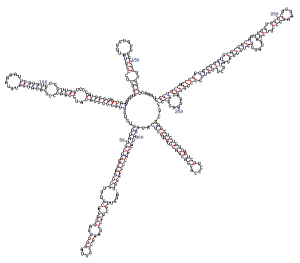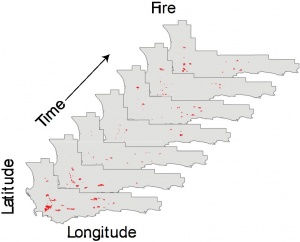Graduate Research Symposium 2007
Biological Sciences and Physics Building. Room 130
9:00 AM - 4:00 PMThe EEB Spring Symposium will be on Saturday, March 31st. This is an all day event where graduate students get a chance to present their research to other graduates and faculty in the department. Regardless of your research level, this symposium provides an opportunity to present project ideas and/or results in a low-stress atmosphere, and obtain valuable feedback from grads and faculty. Because this is an all day event, lunch and snacks will be provided by funds requested from the GSS by our graduate student GSS senators. Grads, please consider giving a talk.
Please submit titles to: molly.letsch@uconn.edu
Early submission of titles is encouraged!

- 8:15-9:00 Breakfast
- 9:00-9:15 Tsitsi McPherson
- Transboundary Protected Areas: potential for the Guiana Shield Corridor
- 9:15-9:30 Suegene Noh
- Testing for preference of song characters in Chrysoperla lucasina
- 9:30-9:45 Kristiina Hurme
- Tadpole schooling and parental care in an aquatic-breeding tropical frog, Leptodactylus insularum
- 9:45-10:00 Nicholas Tippery
- Expanding the phylogenetic utility of the internal transcribed spacer (ITS) region using predicted secondary structure.
- 10:15-10:30 Beth Jacobsen
- Introgression between two NZ cicada species and how are periodical cicadas periodical
- 10:30-11:00 Break
- 11:00-11:15 J. Pablo Arroyo
- Natural Forest Management Plans: A framework for assessing tree diversity in Costa Rica.
- 11:15-11:30 Susan Z. Herrick
- Spatial Interactions of Breeding Male Green Frogs (Rana clamitans) and Bullfrogs (Rana catesbeiana)
- 11:30-11:45 Krissa Skogen
- Does atmospheric nitrogen deposition contribute to the decline of a native nitrogen-fixing species, Desmodium cuspidatum?
- 11:45-12:00 Jang K. Kim
- Are Intertidal Seaweeds More Efficient at Nutrient Absorption?
- 12:00-12:15 Adam Wilson
- The Fire-Weather relationship in the South African Fynbos: Implications under Climate Change
- 12:15-12:30 Roberta Engel
- Origins of pseudoscorpion lineages endemic to the outcrops of southwestern Australia
- 12:30-1:45 Lunch
- 1:45-2:00 Susan Letcher
- Methods for evaluating ecological similarity in large multivariate data sets: an example using forest succession data from northeastern Costa Rica
- 2:00-2:15 Carrie Fyler
- Erection of a new genus: A total evidence approach to tapeworm Systematics
- 2:15-2:30 Karolina Fucikova
- New Algal Species Records for the Great Smoky Mountains National Park, U.S.A.
- 2:30-2:45 Diego Sustaita
- Prey processing in predatory birds: food for thought

Tsitsi McPherson
Transboundary Protected Areas: potential for the Guiana Shield Corridor
Enter Abstract Here
Suegene Noh
Testing for preference of song characters in Chrysoperla lucasina
Enter Abstract Here
Kristiina Hurme
Tadpole schooling and parental care in an aquatic-breeding tropical frog, Leptodactylus insularum
Group-living is a widespread phenomenon among animals that increases survival through increased predator detection and dilution of risk. Parental care is also widespread; parents may increase offspring survival through predator defense, food provisioning or nest building. Despite high levels of predation in aquatic environments, parental care of tadpoles is rare, probably because most adult anurans are terrestrial whereas tadpoles are aquatic. Within the Neotropical genus Leptodactylus, research has revealed an adaptive tendency towards tadpole schooling and female care and the novel use of stereotyped signals in female-offspring communication. Leptodactylus insularum tadpoles form dense aggregations that experience intense predation from terrestrial and aquatic invertebrates. Females attend the eggs and aggregations of tadpoles, and lead these schools to different microhabitats in temporary ponds. I will address multiple hypotheses about the effect of group size on predation risk and oxygen availability in tadpole schools, the biology of parental care, and the genetic composition of female-tadpole groups in Leptodactylus insularum. Additionally, I will discuss current research on growth rates and lung development in tadpoles, the effect of variation in female attendance on offspring growth and survival, and parent-offspring communication.
Nicholas Tippery
Expanding the phylogenetic utility of the internal transcribed spacer (ITS) region using predicted secondary structure.
Molecular phylogenetic methods often are based purely on the linear sequence of nucleotides for the region of interest. Methods that explore additional facets of sequence data include models of codon evolution for protein coding regions and doublet models that account for covarying sites. I have developed a method that extracts further phylogenetically-informative data from the nuclear internal transcribed spacer (ITS) region, based on predicted models of ITS secondary structure. Like their flanking ribosomal genes, the ITS regions (ITS-1 and ITS-2) have secondary structures ('stems' and 'loops') that are conserved across taxonomic groups as divergent as algae and angiosperms. In the method presented, seven conserved structural regions of ITS (three from ITS-1 and four from ITS-2) were encoded for their nucleotide composition and pairwise alignment type (match or mismatch). Data for different taxa were aligned to each othe under the primary criterion of structural similarity, which differed from the traditional, phenetic alignment. Rather than incurring costs simply for changes in nucleotide identity, the method penalized changes that disrupted secondary structure. Thus, by aligning sequences based on structure and assigning costs to structural changes, the method generated phylogenetic data that were nearly independent from the simple nucleotide sequences on which they were based. In an application from the family Menyanthaceae, the method substantially improved support for nodes that were ambiguous under analysis of traditionally aligned sequences.
Beth Jacobsen
Introgression between two NZ cicada species and how are periodical cicadas periodical
Enter Abstract Here
J. Pablo Arroyo
Natural Forest Management Plans: A framework for assessing tree diversity in Costa Rica.
Enter Abstract Here
Susan Z. Herrick
Spatial Interactions of Breeding Male Green Frogs (Rana clamitans) and Bullfrogs (Rana catesbeiana)
Enter Abstract Here
Krissa Skogen
Does atmospheric nitrogen deposition contribute to the decline of a native nitrogen-fixing species, Desmodium cuspidatum?
Enter Abstract Here
Jang K. Kim
Are Intertidal Seaweeds More Efficient at Nutrient Absorption?
Desiccation stress can determine the upper distribution limits and could enhance the uptake of nitrate and ammonium of intertidal algal species. Emersion following desiccation might stimulate several aspects of metabolism. Upper shore species may exhibit greater stimulation of N uptake following desiccation and achieve maximum uptake at higher desiccation levels. The objective of this study was to determine whether Porphyra species from different vertical elevations respond differently to the desiccation stress, in terms of nitrate uptake and growth. The intertidal species (Porphyra umbilicalis) and subtidal species (P. amplissima) were utilized in this study. Both species were cultivated at 100–150 umol m-2 s-1 light intensities, 500 uM nitrate concentration and 10 C (P. umbilicalis). Porphyra amplissima was cultivated at 15 C for three days, and P. umbilicalis was cultivated at 10 C for three weeks at a photoperiod of 12:12h L:D. Samples were exposed to air for 0, 30 min (30-50% water loss) and 2 hrs (90% water loss), 4 hrs after light exposure each day. Desiccation was more stressful to the subtidal species, P. amplissima, than to the intertidal species, P. umbilicalis. When tissues were exposed for 2 hrs daily, P. amplissima lost weight and pigments, while the growth rate of P. umbilicalis dropped by only 30% compared with that of continually submerged blades. Nitrate uptake rate of subtidal P. amplissima was only 73% (30-50% water loss) and 62% (90% water loss) of that of continually submerged tissue. Nitrate uptake rates of P. umbilicalis were not significantly different in each treatment. These results suggest that species in the intertidal zone, which have longer exposure times, may have higher time-use efficiency than the subtidal species in terms of nitrate uptake. This indicates a possible correlation between nitrate uptake and observed vertical distribution patterns.
Adam Wilson
The Fire-Weather relationship in the South African Fynbos: Implications under Climate Change
Fire is a defining component of the fynbos ecosystem in the Cape Floristic Region (CFR) of South Africa. Many ecologically important species require fire for reproduction and the frequency of fire is a primary determinant of species composition. It has been hypothesized that climate change will increase fire frequency by raising temperature and reducing the reliability of rainfall. However, little work has been done to quantify the relationship between fire occurrence and climate factors. I am currently working on spatio-temporal statistical models to explain the monthly variability of fire frequency in mountain fynbos regions from 1980-2000. Preliminary results suggest a clear relationship between temperature, precipitation, and fire events, with more and larger fires occurring in hotter, drier months and years. These findings have important ramifications for conservation and management of fynbos. If climate change leads to higher temperatures or lower rainfall, our models imply that fire frequency will increase. Increased fire frequency will favor re-sprouters and other species that reproduce quickly over plants with slower reproduction cycles. Thus, if the fire regime changes, the community composition of the fynbos could change.
Roberta Engel
Origins of pseudoscorpion lineages endemic to the outcrops of southwestern Australia
Enter Abstract Here
Susan Letcher
Methods for evaluating ecological similarity in large multivariate data sets: an example using forest succession data from northeastern Costa Rica
Since species abundance data sets are often massively multivariate, extracting useful axes of variation is a challenge. Here, I present a data set of woody plant abundance from 30 sites along a forest succession gradient in northeastern Costa Rica, comprising 8914 individuals of 477 species. I summarize the state-of-the-art methods for examining similarity in species composition between sites, performing an ordination based on the similarity matrix, and examining the validity of a priori groupings in the data set. This analysis reveals significant changes in the species composition of sites along a chronosequence.
Carrie Fyler
Erection of a new genus: A total evidence approach to tapeworm Systematics
Enter Abstract Here
Karolina Fucikova
New Algal Species Records for the Great Smoky Mountains National Park, U.S.A.
The Great Smoky Mountains National Park harbors a remarkable biodiversity. Within the All Taxa Biodiversity Inventory (ATBI), a project that has been in progress in the park since 1997, 976 algal taxa have been reported to this day. This number includes a few old historical records from the 1940s, as well as hundreds of taxa reported by the algal Taxonomic Working Group (TWiG) of the ATBI. From the total of 976 taxa, 392 have been added since the last published species record list (2004). Ranges of several algal taxa have been extended as a result of this work. In addition, some new species of diatoms (Bacillariophyta), blue-green algae (Cyanobacteria), green algae (Chlorophyta), and conjugating green algae (Charophyta) have been described. Even more taxa, ca. 50, have not been identified to species level with certainty, and are therefore putative new species as well.
Diego Sustaita
Prey processing in predatory birds: food for thought
Prey processing generally refers to the act of manipulating prey to facilitate its passage through the alimentary tract. Naturally, there is tremendous variation in the way different groups of birds go about this. In predatory birds for instance, this process begins with capturing and killing prey, followed by further processing prior to consumption. Here I discuss my endeavor to study the biomechanics of prey processing and feeding in a predatory songbird – the Loggerhead Shrike – through an intraspecific, ecomorphological approach. Given their morphological and behavioral adaptations for processing vertebrate prey, unique impaling behavior, broad geographic distribution, and omnivorous food habits, shrikes form a particularly interesting system for examining functional trade-offs, and the mechanistic basis to patterns of phenotypic variation.

